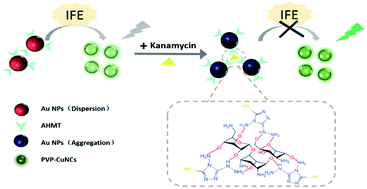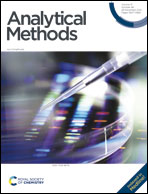A dual-channel colorimetric and fluorescent sensor for the rapid and ultrasensitive detection of kanamycin based on gold nanoparticles-copper nanoclusters†
Abstract
In this work, a dual-channel assay was constructed for the colorimetric and fluorescent detection of kanamycin (KAN) based on gold nanoparticles (Au NPs) and copper nanoclusters (Cu NCs). Initially, the fluorescence of Cu NCs was quenched by 4-amino-3-hydrazino-5-mercapto-1,2,4-triazole (AHMT)-functionalized Au NPs due to the inner filter effect (IFE). The existence of KAN acted as a molecular bridge to interact with AHMT via hydrogen bonds and induced the aggregation of AHMT-Au NPs, leading to a change in the color of the gold colloidal solution from reddish-violet to blue within 2 min. Moreover, the aggregated AHMT-Au NPs can weaken its IFE toward Cu NCs and result in fluorescence restoration. With the sensor employed here, the concentration of KAN can be quantitatively analyzed through double channels, and a low LOD (limit of detection) of 1.9 nM and 1.2 nM was realized by the colorimetric and fluorescent method, respectively. Benefitting from the short response time, high sensitivity, and good reliability, the established assay offered great opportunities for the on-site monitoring of antibiotics in environmental samples.

- This article is part of the themed collection: Analytical Methods HOT Articles 2021


 Please wait while we load your content...
Please wait while we load your content...